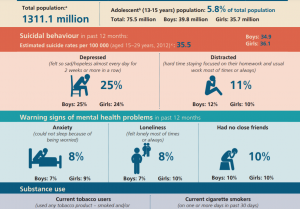
While the Covid-19 pandemic threw individuals off their axis, it pushed children out of their orbit. They were not only dealing with stress and anxiety but battling with the uncertainty of when and whether their world of playing outside and socializing with friends and teachers at school would ever return. Children who lost loved ones during this pandemic lived in fear and grief. Children of families who were suddenly unemployed during the pandemic found themselves in a very stressful home environment. Vikram Beri, a champion of Mental Health talks about the need to address children’s emotional development at homes and institutions. The stigma which revolves around talking about anger management, hurt, disappointment, failures neglect care of emotions, thoughts and the mind. This leads to repercussions in the future, like a dip in their confidence, self-esteem and strongly affects their chances of thriving.
Children’s Mental Health
The treatment gap for mental health disorders such as depression is 88%, for all ages in India. An international journal of psychiatry reveals that the first onset of mental disorders usually occurs in childhood and adolescence, with 12% of psychiatric disorders prevalent among children and adolescent populations in India. The National Mental Health Survey of India (2015-16) estimated that nearly 7% of Indian adolescents between the ages of 13 and 17 suffer from mental health problems. According to the World Health Organisation’s (WHO) Mental Health Status of Adolescents in South-East Asia: Evidence for Action (2017), a quarter of adolescents in India in the 13-15 age group suffer from depression. This report also revealed that 11% of adolescents are distracted, 8% are anxious and suffer consequential sleep disorder, 8% experience loneliness most of the time and 10% were unable to forge friendships.

Image courtesy: Mental Health Status of Adolescents in South-East Asia: Evidence for Action (2017)
With Indian youth already highly susceptible to poor mental health, this pandemic truly was a test.
Remote Learning and Children’s Mental Health
This pandemic saw schools transitioning to remote instruction, throwing children of all ages into disrupted routines and spending hours at home, glued to their computer screens, slowly getting accustomed to a new and for most, a tedious mode of learning. Their studies have suddenly changed from a state of predictability to one of uncertainty in relation with exams and assessments, with little or no clarity on when things will go back to normal.
While younger children struggled to sit in front of the computer screens for periods longer than their attention span could hold, older children were learning how to not only attend classes online but also prepare for assessments to be conducted the same way. Signs of disinterest, loss of motivation, burnout and constant worry about their academic performance have left students feeling anxious and depressed, with their sleeping and eating patterns being compromised. While having their parents at home might have been a welcome move for most children, learning that they are not accessible to them at all hours has also left children feeling frustrated, angry, upset and confused. In certain homes, domestic violence has been on the rise, putting children at risk.
“Remote learning is a challenge. Children generally learn well when actively engaged and in environments where they feel safe and socially connected. While there’s a lot that one can do online – I think there’s been a surge in innovation and adaptation- remote learning required a level of sustained attention and emotional regulation that is a very big demand, developmentally for kids in middle school and younger.” – Archana Basu, Clinical Psychologist at Harvard Medical School
Diagnosis of Children’s Mental Health Issues
No parent wants to witness their child suffer or be in any sort of pain. At the same time, the stigma and sometimes lack of awareness around mental health make this more difficult for parents to understand what is happening with their young children. The primary hurdle in identifying issues around mental health during childhood is that development and behavioral changes are almost always constant. Early signs of mental illnesses can very easily be overlooked by parents as children acting out or going through difficult phases. This isn’t helped by the stigma and taboo attached to mental health in most families, which make open and transparent communication between children and parents about conditions like depression, stress and anxiety almost negligent. If children are not encouraged and motivated to express their feelings, however bad they might be, there is a large chance of them never opening up and acknowledging that there is something bothering them. With domestic and sexual violence on the rise, be it through primary or secondary caregivers, or through cyber portals, children need to know that they can approach their parents or educators when something is bothering them. The lack of awareness in homes and institutions about mental health issues and how prevalent they are in today’s world make most children with any form of mental illness go unnoticed, undetected and if detected, not taken seriously.
Empowering Caregivers to Accept Children’s Mental Health Concerns
The first step to treating children’s mental health issues is getting parents and educators to acknowledge and accept that they exist. Once they begin to acknowledge that mental health issues can be prevented and treated just like any other illness, the stigma around it will slowly ebb. Awareness camps in schools help caregivers of children understand that issues of anxiety, depression and stress can start as young as children in schools and learning disabilities like autism, dyslexia etc. cannot and will not go away by ignoring the symptoms and pushing children to continue as though they were normally abled.
Open conversations with children about their feelings during this pandemic will go a long way in understanding what their thoughts are, including fears and anxieties. Some children might be worried that they will never see their friends again while others might be concerned about their families’ safety and health. Discussions with children about their anger, disappointments, failures and pain points due to this pandemic can enable them to calm their minds and feel that things will get better and that their caregivers will take care of and protect them, no matter what. Educators can have regular check-in sessions with their students to gauge how they are faring at home and identify any concerning mental health issues, and alert parents to observe and monitor their children, in such cases. Certain students might be in dangerous homes where domestic violence and abuse is prevalent, which might make children more prone to be disinterested or silent. If educators are trained to pick up on such cues, they can help protect such children by taking timely action and notifying the right authorities.
With the whole world going remote, diagnostic tools to assess development delays in children and other mental health and behaviour concerns can be accessed by caregivers while sitting in the comfort of their own homes. Pearson has developed PreK-16 Education and Special Needs Assessment tools which enable parents and educators to assess mental health and behaviour concerns of their teens and adolescents, unique to their age group and assist in making reliable diagnostic and treatment decisions. The kit also contains a comprehensive assessment tool for determining cognitive, language and motor development delays in children, when they are toddlers so that remedial action can start early. Worried that your child may have a learning disability? They have that covered as well with an accurate and easy-to-administer test to assess and monitor the reading, spelling and math skills of young children, helping parents with early diagnosis. The earlier the detection and diagnosis of development delays and mental health issues, the faster they can be identified and treated. A young child’s development can be assessed in the five key domains of cognition, language, social-emotional, motor and adaptive behaviour, using Bayley Scales of Infant and Toddler Development – Third Edition (Bayley III).
While families and communities are gradually adapting to the constantly evolving changes brought on by the pandemic, the onus falls on parents, educators and other primary caregivers to help their children adjust to this new normal. Allowing children to feel their emotions and express them whenever and however they know how while they adjust and keep up with these changes is a must. As adults, it is pertinent to give children guidance on how to react to stressful situations and help them develop the skills to positively regulate their emotions. If and when in doubt, reaching out to educators or mental health service providers can help ease parents’ and children’s anxieties and fears. Validating what your children are feeling is telling them that their feelings and wellbeing matter and that you will do anything and everything in your power to make them feel better.
Mental health is just as important as physical health and that should be normalized, as early as with children in schools and homes.
Author:
Anjali Paul,
Content writer




